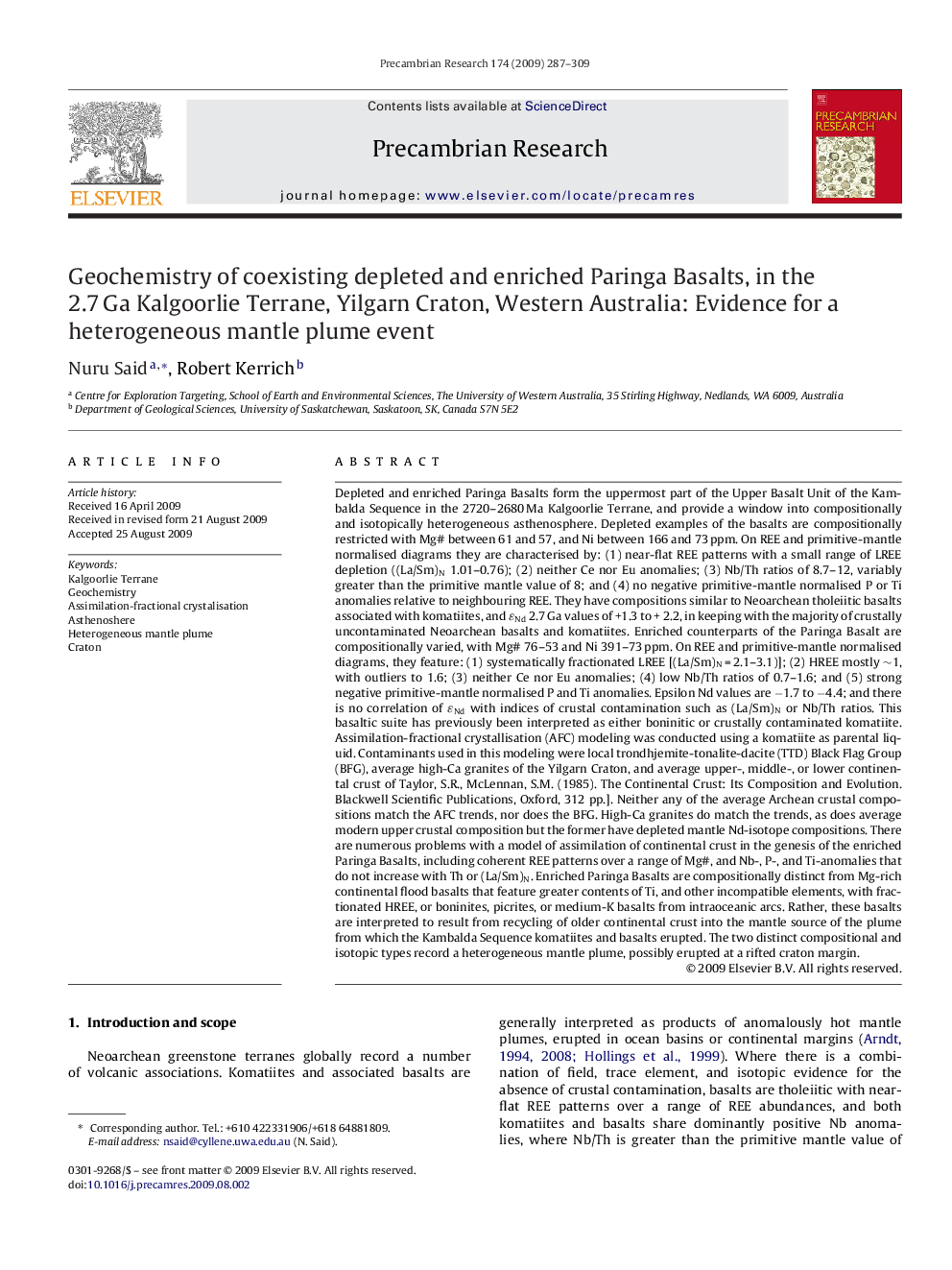| کد مقاله | کد نشریه | سال انتشار | مقاله انگلیسی | نسخه تمام متن |
|---|---|---|---|---|
| 4723915 | 1639685 | 2009 | 23 صفحه PDF | دانلود رایگان |

Depleted and enriched Paringa Basalts form the uppermost part of the Upper Basalt Unit of the Kambalda Sequence in the 2720–2680 Ma Kalgoorlie Terrane, and provide a window into compositionally and isotopically heterogeneous asthenosphere. Depleted examples of the basalts are compositionally restricted with Mg# between 61 and 57, and Ni between 166 and 73 ppm. On REE and primitive-mantle normalised diagrams they are characterised by: (1) near-flat REE patterns with a small range of LREE depletion ((La/Sm)N 1.01–0.76); (2) neither Ce nor Eu anomalies; (3) Nb/Th ratios of 8.7–12, variably greater than the primitive mantle value of 8; and (4) no negative primitive-mantle normalised P or Ti anomalies relative to neighbouring REE. They have compositions similar to Neoarchean tholeiitic basalts associated with komatiites, and ɛNd 2.7 Ga values of +1.3 to + 2.2, in keeping with the majority of crustally uncontaminated Neoarchean basalts and komatiites. Enriched counterparts of the Paringa Basalt are compositionally varied, with Mg# 76–53 and Ni 391–73 ppm. On REE and primitive-mantle normalised diagrams, they feature: (1) systematically fractionated LREE [(La/Sm)N = 2.1–3.1)]; (2) HREE mostly ∼1, with outliers to 1.6; (3) neither Ce nor Eu anomalies; (4) low Nb/Th ratios of 0.7–1.6; and (5) strong negative primitive-mantle normalised P and Ti anomalies. Epsilon Nd values are −1.7 to −4.4; and there is no correlation of ɛNd with indices of crustal contamination such as (La/Sm)N or Nb/Th ratios. This basaltic suite has previously been interpreted as either boninitic or crustally contaminated komatiite. Assimilation-fractional crystallisation (AFC) modeling was conducted using a komatiite as parental liquid. Contaminants used in this modeling were local trondhjemite-tonalite-dacite (TTD) Black Flag Group (BFG), average high-Ca granites of the Yilgarn Craton, and average upper-, middle-, or lower continental crust of Taylor, S.R., McLennan, S.M. (1985). The Continental Crust: Its Composition and Evolution. Blackwell Scientific Publications, Oxford, 312 pp.]. Neither any of the average Archean crustal compositions match the AFC trends, nor does the BFG. High-Ca granites do match the trends, as does average modern upper crustal composition but the former have depleted mantle Nd-isotope compositions. There are numerous problems with a model of assimilation of continental crust in the genesis of the enriched Paringa Basalts, including coherent REE patterns over a range of Mg#, and Nb-, P-, and Ti-anomalies that do not increase with Th or (La/Sm)N. Enriched Paringa Basalts are compositionally distinct from Mg-rich continental flood basalts that feature greater contents of Ti, and other incompatible elements, with fractionated HREE, or boninites, picrites, or medium-K basalts from intraoceanic arcs. Rather, these basalts are interpreted to result from recycling of older continental crust into the mantle source of the plume from which the Kambalda Sequence komatiites and basalts erupted. The two distinct compositional and isotopic types record a heterogeneous mantle plume, possibly erupted at a rifted craton margin.
Journal: Precambrian Research - Volume 174, Issues 3–4, November 2009, Pages 287–309